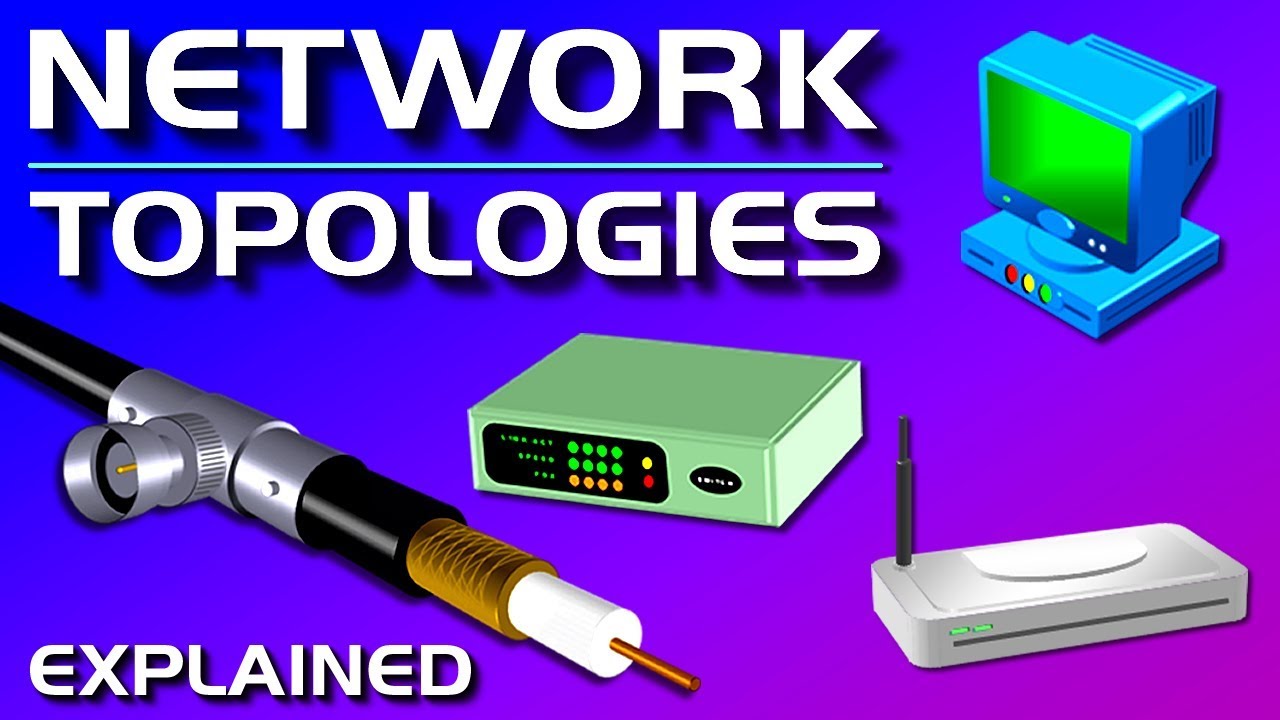What are network topologies? A topology is the layout of how a network communicates with different devices. And there are a couple of different categories of topologies There’s wired and wireless.
Network Topologies
Star Network
We’re first going to talk about the most common wired topologies. And the most common wired topology that’s used is the star topology. In a star topology, all computers are connected to a central wiring point, such as a hub or a switch. All data on a star network passes through this central point before continuing to its destination. One of the major benefits of this topology is that if one computer failed or if there was a break in the cable the other computers would not be affected because each computer has their own cable connection. However, a disadvantage of the star topology is that if the central hub or switch fails, then all the computers on that central point would be affected. This is called a single point of failure. If this happens the entire network goes down.
Ring Network
Another type of topology is called a ring. The ring topology is a type of network configuration where each computer is connected in the shape of a closed loop or ring. So every computer on this ring has exactly two neighbors for communication purposes. Each data packet is sent around the ring until it reaches its final destination. This kind of topology is rarely used today. The advantage of a ring topology is that they are easy to install and easy to troubleshoot. However, the disadvantage would be, that if just one of these computers goes down or if there was a single break in the cable, then all data flow would be disrupted.
Bus Network
And the next one is the bus topology The bus topology is very old technology and like the ring topology, it is not used today that much. This is the kind of network setup where each of the computers and network devices, are connected to a single cable or backbone. and this backbone is a coaxial cable. The computers connect to this cable using special connectors called BNC, which are also known as T connectors. One of the advantages of the bus topology is that it is also fairly cheap and easy to implement.
However, a disadvantage of the bus topology is that it requires that the cable is terminated at both ends using terminators. For this setup to remain operational, there must not be any open connections, including the ends that attach to the computers. So if a computer is removed or if the terminators are loose or missing, then the cable would be open and data would bounce back. This bounce is known as signal reflection, and if this happens data flow would be disrupted. There is also the mesh topology.
Mesh Network
In a mesh topology, each computer on the network is connected to every other computer on the network. So by having so many connections, it handles failure very well. In this illustration, there are 4 computers with 3 connections on each computer, which makes a total of 12 connections for this network. The advantage of a mesh topology is that it creates a high redundancy level. Because if one or more connections fail, the computers would still be able to communicate with each other. However because of the amount of cabling and network cards that have to be used, mesh topologies can be expensive, so they are rarely used on local area networks or LANs.
They are mainly used on wide area networks, like the internet. In fact, the internet is a good example of a mesh topology. Because the internet is made up of numerous routers, all over the world that are connected to each other to route data to their intended destination. So even if a few routers go down, the data will get rerouted using a different path to ultimately reach their destination. So the internet is very redundant because it uses a mesh topology.
Wireless Topologies
Infrastructure Wireless
Now we’re going to talk about wireless topologies. So let’s start with infrastructure wireless topology. This topology uses a combination of wired and wireless devices. This is very similar to a star topology, where you have wired devices, such as these computers here, physically connected to a switch. And you also have a wireless access point that’s also connected by a cable to the same switch. The wireless access point is here so that wireless devices, such as laptops, tablets, cell phones, etc, can connect wirelessly to the network. So the wireless access point acts like a bridge between the wireless network and the wired network. Now the infrastructure topology is not limited to a single wireless access point. You can have multiple wireless access points if you want. It just depends on the needs of the network.
Ad hoc Wireless
The next wireless topology is Ad hoc. Ad hoc is a very simple wireless topology. It’s simple because it doesn t rely on any infrastructure, such as cables, routers, servers, or wireless access points. All the devices in an ad hoc network, wirelessly connect to other devices in a simple peer-to-peer network. They directly connect to each other without using a centralized device, such as a wifi router or access point. And because they directly access each other without a server or router in between, each device is responsible for its own security and permissions. Ad hocs are useful for setting up a quick wireless network on the fly, where devices can share data without the need for an existing wireless network.
Mesh Wireless
The last wireless topology is called a wireless mesh. Wireless mesh topologies are similar to wired mesh topologies, where devices are interconnected with each other, but with the exception that they are wirelessly interconnected. So for example, let’s say you wanted to deploy multiple wireless access points all throughout a building so that wireless devices that are in different areas are able to access the internet. So normally you would have a modem that brings in the internet to the building, and then you would have a switch that’s connected to the modem. And then you would connect each wireless access point with a cable to the switch. So by doing it this way, this requires extra cabling and it would also require extra time running the cables through the building. So this is more expensive and more time-consuming.
Now a wireless mesh topology would be similar to this setup, but without the need for these extra cables. In a wireless mesh, each wireless access point with talk to other wireless access points to create a seamless internet connection for wireless devices to connect to. So if this laptop over here wanted to access the internet, it would connect to the nearest wireless access point and then this access point would relay the connection to the next access point and then the next one and eventually find its way back to the modem. So no matter which access point you’re connected to, you will have internet access because all the access points are in constant communication with each other and the modem. And even if one or more access points were to fail, it wouldn’t matter, because the other access points will reroute the data. So a wireless mesh topology is very redundant…because the internet connection is spread out over many wireless access points.
Conclusion:
In conclusion, network topologies define how devices in a network communicate with each other, with variations including wired and wireless configurations. Here’s a summary of the main points covered:
Wired Topologies:
- Star Topology: Commonly used, with all devices connected to a central hub or switch. Offers individual cable connections for each device but can suffer from a single point of failure.
- Ring Topology: Features a closed loop where each device connects to exactly two neighbors. Rarely used due to potential disruptions if a single device fails or if there’s a break in the cable.
- Bus Topology: Older technology where devices connect to a single coaxial cable backbone. Relatively cheap and easy to implement but requires proper termination to prevent data disruptions.
Mesh Topology:
- Connects every device to every other device, ensuring high redundancy and resilience to failures. While expensive due to cabling and network card requirements, it’s ideal for wide-area networks like the Internet.
Wireless Topologies:
- Infrastructure Wireless: Combines wired and wireless devices, with wireless access points bridging the gap between wired and wireless networks.
- Ad hoc Wireless: Simple peer-to-peer connections between devices without any infrastructure, suitable for setting up quick wireless networks.
- Wireless Mesh: Devices are wirelessly interconnected, providing seamless internet access through multiple access points. Highly redundant and resilient to failures.
Each topology has its advantages and disadvantages, catering to different network requirements and environments. Understanding these topologies is crucial for designing efficient and reliable network infrastructures.



